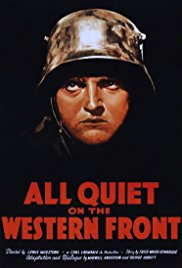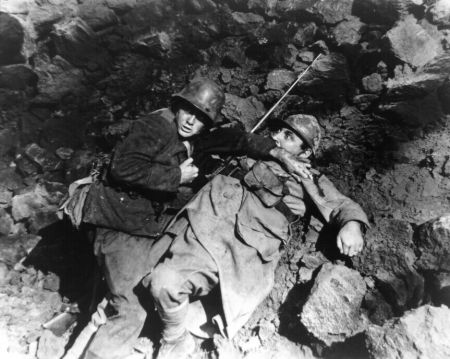5. During the battle scenes, did you want the Allied soldiers to win or did you want Paul and his German friends to win? What does this tell you about the mental process by which a person reads a book or sees a movie?
Suggested Response:
There is no one correct response, but any strong response will take account of the pull on our feelings of the German soldiers. People identify with the main characters in stories told in books, movies, and on the stage. This makes stories excellent means for spreading propaganda.
6. Most people believe that it’s a good thing to be patriotic. The young men shown in this movie were motivated by patriotic feelings to enlist in the German Army. What does this story tell us about patriotism?
Suggested Response:
Patriotism can be misused. After their experience at the front the young men are disillusioned and interested mostly in survival.
7. When Paul returned home on leave, why did the schoolboys think him a coward?
Suggested Response:
A strong response will refer to the ignorance of the boys about conditions at the front and to the empty patriotic slogans mouthed by their teacher.
8. Were Paul and his friends courageous? Was any one of them a coward?
Suggested Response:
Any soldier who puts his or her life at risk is courageous.
9. Compare the courage [patriotism] of a soldier who risks his life with the approval and upon the demand of his society and the courage of a man like Ben du Toit in A Dry White Season who risks his life by turning against his community when he recognizes that it is committing evil, in this case Apartheid, who is virtually alone in his quest for justice, who is perceived by his community and his government as being a traitor, and who risks torture or death for his actions. Who has the greater courage?
Suggested Response:
There is no one correct response. Each type of courage is different. There is probably more likelihood of getting injured in a war situation, but soldiers are generally supported by the population and the other soldiers in the unit, whereas a reformer for social change is often alone and isolated. In many situations, social reformers are under great threat, even in stable democracies such as the United States. Look at what happened to Dr. M.L. King, civil rights worker Medgar Evers (see Ghosts of Mississippi) and the women who picketed the White House seeking the vote (see Iron Jawed Angels).
10. When Paul went home on leave, how do you think he felt about the way his friends and family thought about the war?
Suggested Response:
Any reasoned and supported response is correct. Paul was conflicted. He knew that they had no idea how terrible it was at the front and that their feelings of patriotism were uninformed and untested by the real horrors of war.
11. How can war be reconciled with the moral imperative to respect others and to deal peacefully with anger, insults and disagreements?
Suggested Response:
War results in contradictions. People are told that they should do things, such as kill or maim others, that are prohibited in other situations.
12. What does Paul’s sympathy and concern for the dying enemy soldier demonstrate?
Suggested Response:
That the war had not completely dulled his ability to care.
13. When should the value of caring for another human being prevail over the dictates of war?
Suggested Response:
Mahatma Gandhi, the greatest moral leader of the 20th century, would tell us that principles of non-violence should prevail all the time. See Learning Guide to Gandhi. But most people admit that they cannot live up to Gandhi’s standards. However, it is interesting to note that the standards of war have changed. In World War II, just over 50 years ago, all sides killed civilian populations indiscriminately.. The Germans and Japanese started it and the Allies paid them back many times over causing civilian casualties in the hundreds of thousands bombing Dresden, Tokyo, Hiroshima, Nagasaki and many other population centers. This conduct would not be tolerated in today’s world in which a drone attack that kills ten or twenty civilians will result in an apology.
14. Could you think of a better way for Paul to have helped his country other than to go to war?
Suggested Response:
There is no one correct response to this question.
See also TWM’s Discussion Questions for Use With any Film that is a Work of Fiction.






